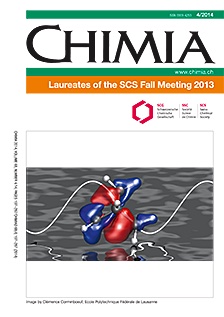Development and Evaluation of Novel PET Tracers for Imaging Cannabinoid Receptor Type 2 in Brain
DOI:
https://doi.org/10.2533/chimia.2014.208Keywords:
Autoradiography, Cannabinoid receptor type 2 ligand, Neuroinflammation, Positron emission tomography, RadiolabelingAbstract
The cannabinoid receptor type 2 (CB2) has a very low expression level in brain tissue under basal conditions, but it is up-regulated in diverse pathological conditions. Two promising lead structures from the literature, N-((3S,5S,7S)-adamantan-1-yl)-8-methoxy-4-oxo-1-pentyl-1,4-dihydroquinoline-3-carboxamide and 8-butoxy-N-(2-fluoro-2-phenylethyl)-7-methoxy-2-oxo-1,2-dihydroquinoline-3-carboxamide – designated KD2 and KP23, respectively – were evaluated as potential PET ligands for imaging CB2. Both KD2 and KP23 were synthesized and labeled with carbon-11. In vitro autoradiographic studies on rodent spleen tissues showed that [11C]KD2 exhibits superior properties. A pilot study using [11C]KD2 on human post mortem ALS spinal cord slices indicated high CB2 expression level and specific binding, a very exciting finding if considering the future diagnostic application of CB2 ligands and their utility in therapy monitoring. In vivo blocking studies in rats with [11C]KD2 showed also high specific uptake in spleen tissue. Although the protein-bound fraction is relatively high, KD2 or KD2 derivatives could be very useful tools for the non-invasive investigation of CB2 levels under various neuroinflammatory conditions.Downloads
Published
2014-04-30
Issue
Section
Scientific Articles
License
Copyright (c) 2014 Swiss Chemical Society

This work is licensed under a Creative Commons Attribution-NonCommercial 4.0 International License.
How to Cite
[1]
R. Slavik, D. Bieri, S. Čermak, A. Müller, S. D. Krämer, M. Weber, R. Schibli, S. M. Ametamey, L. Mu, Chimia 2014, 68, 208, DOI: 10.2533/chimia.2014.208.







